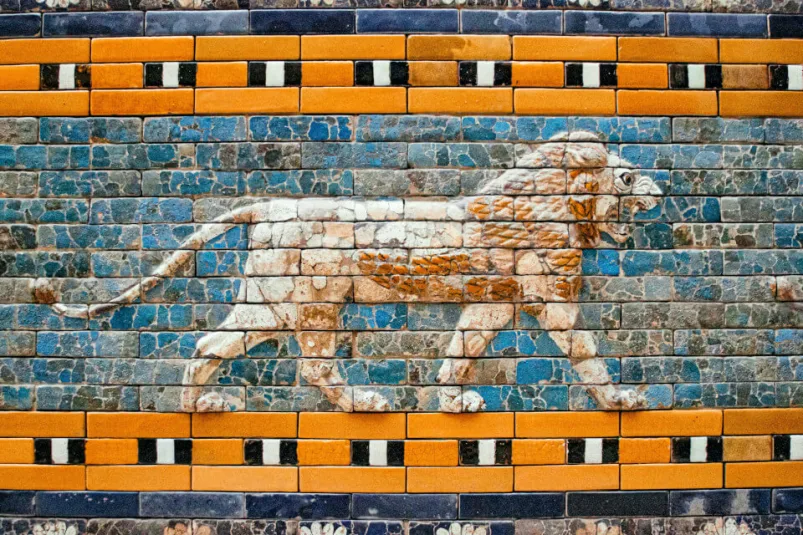Top 5 Facts about the Ishtar Gate

One of the largest and most spectacular monuments in the Berlin museums is the Ishtar Gate located in the Pergamon Museum. What is that exactly? Where is it from? What is its significance? Here's a quick background sketch, plus the top five interesting facts about the Ishtar Gate in Berlin (also shown in this video):
Where is the Ishtar Gate from?
The Ishtar Gate is a part of the massive walls that once surrounded the ancient city of Babylon. Babylon is so legendary, especially because of the Christian mythology told about it in the Bible, that many people don’t realize that it was a real place!
But it was: it is located in what is now Iraq, at the city now known in Arabic as Babel. It has been archaeologically researched, although unfortunately there isn’t terribly much of the city left because the path of the Euphrates river nearby has shifted over time and swallowed up many of the remains. But the city walls were so huge, they survived fairly well. King Nebuchadnezzar built them in the years just after 600 BC. Today at the site of Babel, there is a reproduction of the Ishtar Gate set up for tourists.
How tall is the Ishtar Gate ?
The Gate is almost 15 meters high (the exact dimensions are: 14,75 m high, 26,41 m wide and 4,38 m thick).
Let’s take a closer look at five fast facts about the Ishtar Gate:
1. Made of glazed mud brick
Resources in this arid region of the world are scarce. The two main resources are bitumen – a sticky black sludge that oozes in the ground, geologically related to the oil that is so well-known from the modern Middle East – and….mud.
This gate is made of mud bricks. But here the mud is covered by a glaze in a gorgeous blue color, inspired by lapis lazuli. As awe-inspiring as it is today, it would have been even more so in antiquity: this huge, dazzling blue monument would have stood out next to the beige, flat desert, and the other smaller beige constructions of the city.
2. Covered with animal gods
Two kinds of animals cover the gate, and one more covers the walls leading up to the gate. The pale-colored bull is Adad, the weather god. The yellow-brown dragon (called a “mushushu” by the Babylonians) is Marduk, the top god of Babylonian religion.
The lions on the walls leading to the gate have a triple meaning. They welcome the trusted city dwellers and repel potential enemies. And they are a symbol of Ishtar, the goddess of love and war, because they are like her: beautiful, even seductive, as well as powerful and awe-inspiring.
3. Dedicated to Ishtar
The name we use today for the gate, the Ishtar Gate, derives from a stone tablet found buried under the gate. The inscription on the tablet says that this construction honors the goddess Ishtar. Things buried under monuments were common in Babylon: these so-called “foundation deposits” secured favor from the gods, and immortalized the king who ordered the construction.
Because Ishtar is the goddess of love and war, she is extremely powerful. You don’t want to get her angry! She appears in the great Babylonian hero story called the Epic of Gilgamesh (like the Odyssey for the Greeks). In this story, Ishtar threatens that if she doesn’t get what she wants, she’ll go down into the underworld, gather up all the dead souls there, bring them up into this world, and make them eat the living beings. It’s the world’s oldest zombie story! So the Babylonians felt it was important to appease her with nice things, like a shiny blue city gate.
4. Part of New Year’s celebration
When was the gate used? Likely every day, but it was probably especially important during the new year’s celebration. A parade came up the lion-lined street to the city gate, then passed through it on the way to the all-important temple of Marduk. For the Babylonians, the new year didn’t start in January – there was no January yet, and anyway, what could possibly be new in the middle of winter?
The new year for the Babylonians was the start of spring, when it was obvious that nature was erupting into flower, sleeping seeds burst to life, things were rejuvenating and re-NEW-ing. (Springtime was also celebrated in parts of Europe as the New Year until the modern period.)
5. Shows power of Babylon’s King
Why put all the effort into a gate with thousands of perfectly glazed bricks arranged into different animals and patterns? Because Babylon’s king had something to say, and he did it through this construction project. He wrote a text onto the gate’s left side in the first-person voice:
"I built this gate with wooden doors (wood came from Lebanon and was expensive to bring all the way to Babylon – that showed wealth and power)… so that all of mankind may wonder at it."
The king wanted to impress people! And he wanted to show them that he was working hard to please the gods – Adad, Marduk, and Ishtar – so that they would be kind to all the Babylonians. Big public works like this have been used in similar ways for thousands of years, not least in Saddam Hussein’s replica of the Ishtar Gate now at Babel. Can you think of other examples?
This article was first published on https://museums.love.

Stephanie Pearson
Founder, museums.love
Berlin's Museum Island has been my haunt as a guide, translator, and teacher since 2012. I love bringing visitors the best stories from museums, and doing so in digital media has helped me discover Berlin's cultural landscape from a whole new angle.